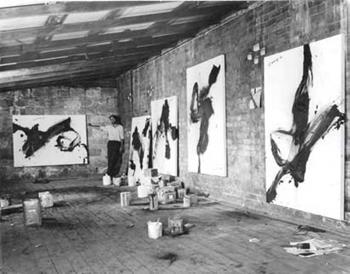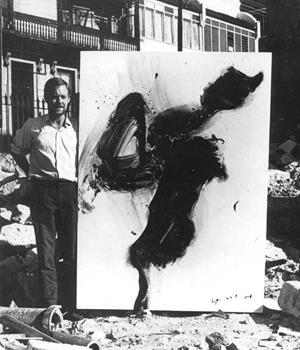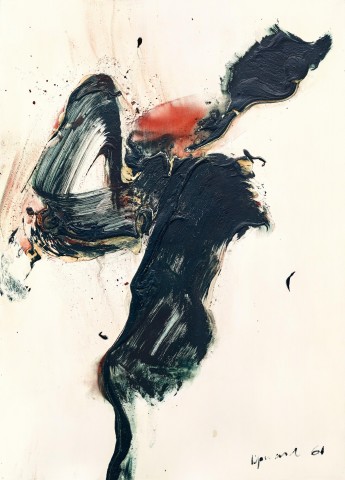JANUARY SEVENTH, 1961
PETER UPWARD
oil and synthetic polymer paint on composition board
190.5 x 136.5 cm
signed and dated lower right: Upward 61
bears inscription verso: U
Blake Prize 1961 label attached verso [not entered]
Robert Shaw, Sydney
Thence by descent
Private collection, Sydney
New Realities by Peter Upward, Terry Clune Galleries, Sydney, 24 May 1961, cat. 1
On long-term loan to the Art Gallery of New South Wales, Sydney, June 1990 – January 2003 (label attached verso)
Frozen Gestures, The Art of Peter Upward, Penrith Regional Gallery & The Lewers Bequest, NSW, 20 October – 2 December 2007, cat. 13
France, C., New Directions 1952 – 1962, Penrith Regional Gallery & The Lewers Bequest, New South Wales, 1991, pp. 16 (illus. in studio), 39 (illus. with artist)
Dean, C., Frozen Gestures, The Art of Peter Upward, Penrith Regional Gallery & The Lewers Bequest, New South Wales, 2007, pp. 8 (illus. with artist), 13 (illus. in studio), 30 (illus.), 54
PETER UPWARD 1.jpg

Peter Upward represents a high water mark of prevailing over the ideological battles between Melbourne and Sydney in the fifties and early sixties. His art was the reason for flitting between the two cities and, eventually, leaving Australia. His idiosyncratic single-mindedness establishes him as one of Australia’s most important painters of the late twentieth century. He wasn’t interested in regional variations of new trends: the vastness of his interests and his imagination allow us to view his work as universal. His art makes perfect modernist sense in Australia, East Asia, America or Europe.
When we think of his inspired conviction other great painters untroubled with the absence of local focuses come to mind: Ian Fairweather, Grace Crowley, Ralph Balson and Godfrey Miller, each a generation earlier than Upward.
He studied at RMIT in 1951, with its capable and conformist modernism, but that lasted for a year.1 When Upward left Melbourne for Sydney later in the year he enrolled at the Julian Ashton Art School under John Passmore. John Olsen recalled the tone, ‘His lyrical nature did not respond to the more stoical side of Passmore’s exercises and he was happier drawing fluently from the model, which satisfied his natural feeling for the immediate.’2
In 1955, he returned to Melbourne, the city of his birth. It was not a satisfying time but his friendship with Clement Meadmore was close. They lived and worked together in a haphazard arrangement in Johnston Street, Collingwood. Jazz was a hugely important part of their lives and never diminished, improvisation and impulse their instinctive drawcard.
In 1959, Upward had an exhibition at Melbourne’s Museum of Modern Art, then on top of a three-level warehouse in the city.3 It was the year Gallery A opened in Flinders Lane, later moving to South Yarra, and in 1964 it opened in Sydney.4 The Antipodeans exhibition of 1959 and its manifesto told artists what they should paint. Some felt it made Melbourne an uncertain place where original and adventurous imaginations might not flourish.5
Upward held an exhibition at Gallery A in 1960 and headed to Sydney with Clement Meadmore. Figuration was anathema to them. Upward rented a shed in Brougham Street, Woolloomooloo and it was here that some of his finest works were created. January Seventh, 1961 is one which points to his greatness. In many respects it is just as important as June Celebration in allowing us to appreciate the reach and characteristics of his interests and their execution.6
Abstract expressionism is a term often applied to Upward’s paintings and it’s almost a lazy catch-all. Robert Hughes’ original insight was closer to the mark: ‘Franz Kline has often been invoked as a parallel to, or an influence on, Upward’s dramatic swathes … but this is quite misleading. Upward is a calligraphic painter, Kline is not. The act of painting becomes a form of limited meditation …’7 This observation leads us to Upward’s interest in Japan. He had read and owned a copy of the seminal book by D T Suzuki, Zen and Japanese Culture.8 Ideas such as practised spontaneity would not be a contradiction to him.
PETER UPWARD 2.jpg

January Seventh belongs to a group of large works which were painted on the floor. Brushes, ladles, even brooms were essential to the physical energy used in an act of creative and masterly intuition. Nothing is reckless and the gestures hold an expressive poise and grand elegance. In one sense they might be seen as evocative of Shoji Hamada’s ladle-poured glazes and, of course, the ink-loaded brushed and single-gestured Japanese calligraphy.9 The Gutai Group emerged after the war and embraced radical individualism as a way of breaking free from the Japanese collectivist mindset. Their desire was physical action with materials themselves – the connection between Gutai and Upward is inescapable. He spent almost a decade in London from 1962, but his gaze was to the East, counterculture and the Beat Generation.
Ideas shaped from curiosity and well beyond a modernism taken and adapted to incorporate local subject matter is the cornerstone of Upward’s career. While June Celebration might be his familiar and much quoted career highlight, January Seventh is no less significant in a life which ended prematurely and unexpectedly at the age of 51, walking near Balmoral Beach, Sydney.
1. The Royal Melbourne Institute of Technology was established as the Working Men’s College in 1887. In 1951 the painting teacher was Lindsay Edward.
2. Olsen, J., ‘Obituary: Peter Upward’, Art and Australia, Sydney, vol. 21, no. 4, Winter 1984, p. 456
3. The Museum of Modern Art was founded by John Reed in 1958.
4. Gallery A opened in 1959, backed by businessman Max Hutchinson and run by Clement Meadmore. It moved to South Yarra in 1962 with James Mollison as a director.
5. The Antipodeans Exhibition was held at the Victorian Artists Society in August, 1959. Bernard Smith wrote the manifesto. The Sydney Nine group, all abstractionists, of which Upward was a member, was created in response to the Antipodeans.
6. June Celebration, 1960, synthetic polymer paint on composition board (three panels), 213.5 x 411.5 cm, National Gallery of Australia, Canberra, Purchased 1972
7. Hughes, R, The Art of Australia, Penguin Books Australia, 1966, p. 282
8. Suzuki, D. T., Zen and Japanese Culture, Pantheon Books, New York, 1959
9. Shoji Hamada (1894 –1978) was a significant influence on Western studio pottery. In 1955, he was designated a ‘Living National Treasure’.
DOUG HALL
